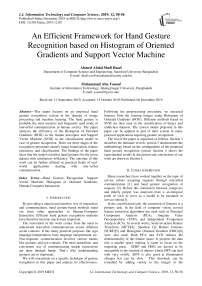An Efficient Framework for Hand Gesture Recognition based on Histogram of Oriented Gradients and Support Vector Machine
Автор: Ahmed Abdal Shafi Rasel, Mohammad Abu Yousuf
Журнал: International Journal of Information Technology and Computer Science @ijitcs
Статья в выпуске: 12 Vol. 11, 2019 года.
Бесплатный доступ
This paper focuses on an empirical hand gesture recognition system in the domain of image processing and machine learning. The hand gesture is probably the most intuitive and frequently used mode of nonverbal communication in human society. The paper analyzes the efficiency of the Histogram of Oriented Gradients (HOG) as the feature descriptor and Support Vector Machine (SVM) as the classification model in case of gesture recognition. There are three stages of the recognition procedure namely image binarization, feature extraction, and classification. The findings of the paper show that the model classifies hand gestures for the given dataset with satisfactory efficiency. The outcome of this work can be further utilized in practical fields of real-world applications dealing with non-verbal communication.
Hand Gesture Recognition, Support Vector Machine, Histogram of Oriented Gradients, Human-Computer Interaction
Короткий адрес: https://sciup.org/15017094
IDR: 15017094 | DOI: 10.5815/ijitcs.2019.12.05
Список литературы An Efficient Framework for Hand Gesture Recognition based on Histogram of Oriented Gradients and Support Vector Machine
- Cho, Mi-Young, and Young-Sook Jeong. "Human gesture recognition performance evaluation for service robots." 2017 19th International Conference on Advanced Communication Technology (ICACT). IEEE, 2017.
- Rahman, Md Abdur, and M. Shamim Hossain. "A gesture-based smart home-oriented health monitoring service for people with physical impairments." International Conference on Smart Homes and Health Telematics. Springer, Cham, 2016.
- Yang, Geng, et al. "A Novel Gesture Recognition System for Intelligent Interaction with a Nursing-Care Assistant Robot." Applied Sciences 8.12 (2018): 2349.
- Azeem, A., et al. "Hexagonal scale invariant feature transform (H-SIFT) for facial feature extraction." Journal of applied research and technology 13.3 (2015): 402-408.
- Kashif, Muhammad, et al. "Feature description with SIFT, SURF, BRIEF, BRISK, or FREAK? A general question answered for bone age assessment." Computers in biology and medicine 68 (2016): 67-75.
- Dalal, N.; Triggs, B., "Histograms of oriented gradients for human detection," Computer Vision and Pattern Recognition, 2005. CVPR 2005. IEEE Computer Society Conference on, vol.1, no., pp.886,893 vol. 1, 25-25 June 2005
- Prasuhn, L.; Oyamada, Y.; Mochizuki, Y.; Ishikawa, H., "A HOG-based hand gesture recognition system on a mobile device," Image Processing (ICIP), 2014 IEEE International Conference on, vol., no., pp.3973,3977, 27-30 Oct. 2014
- Tavakoli, Mahmoud, et al. "Robust hand gesture recognition with a double channel surface EMG wearable armband and SVM classifier." Biomedical Signal Processing and Control 46 (2018): 121-130.
- Tsironi, Eleni, et al. "An analysis of convolutional long short-term memory recurrent neural networks for gesture recognition." Neurocomputing 268 (2017): 76-86.
- Maharani, Devira Anggi, Hanif Fakhrurroja, and Carmadi Machbub. "Hand gesture recognition using k-means clustering and support vector machine." 2018 IEEE Symposium on Computer Applications & Industrial Electronics (ISCAIE). IEEE, 2018.
- Kumar, Pradeep, et al. "Coupled HMM-based multi-sensor data fusion for sign language recognition." Pattern Recognition Letters 86 (2017): 1-8.
- Raheja, J. L., et al. "Robust gesture recognition using Kinect: A comparison between DTW and HMM." Optik 126.11-12 (2015): 1098-1104.
- Beke, Aykut, Ahmet Arda Yuceler, and Tufan Kumbasar. "A rule based fuzzy gesture recognition system to interact with Sphero 2.0 using a smart phone." 2017 International Artificial Intelligence and Data Processing Symposium (IDAP). IEEE, 2017.
- Hongyi Liu, Lihui Wang, “Gesture recognition for human-robot collaboration: A review”,International Journal of Industrial Ergonomics,Volume 68,2018,, Pages 355-367, ISSN 0169-8141
- Michal Kawulok, Jolanta Kawulok, and Jakub Nalepa. 2014, “Spatial-based skin detection using discriminative skin-presence features”, Pattern Recogn. Lett. 41, C (May 2014), 3-13.
- Michal Kawulok, Jolanta Kawulok, and Jakub Nalepa. 2014, “Self-adaptive algorithm for segmenting skin regions”, EURASIP Journal on Advances in Signal Processing2014.
- Michal Kawulok, Jolanta Kawulok, and Jakub Nalepa. 2014, “Wrist Localization in Color Images for Hand Gesture Recognition”, Volume 242 of the series Advances in Intelligent Systems and Computing pp 79-86


